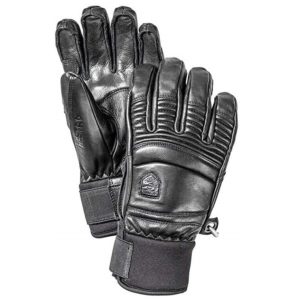




Each skier needs to be well prepared for the winter season. Ski gloves are a vital factor that any skier requires. When your body is cold, your blood exits your extremities to keep your internal organs and your mind from shutting. You should protect your fingers and toes when skiing or snowboarding at any cost. And that is when a good pair of leather ski gloves can be very useful.
5 reasons to invest in leather ski gloves:
- High-quality leather gloves are always waterproof with wax or synthetic materials;
- Quick break-in for a few hours – they won’t get stiff;
- Durable and tough to withstand any accidents;
- Dense enough to keep even your fingertips warm during all the cold day long;
- Touchscreen option – you will be able to use your smartphone without taking the gloves off;
If you’ve ever questioned what the distinction is between different styles of ski gloves, or whether you just want to get a deeper understanding of waterproofing and the practical structure of a good pair of ski gloves, you’ve come to the right spot.
The following guide will show you how to pick up the most fitting and safe leather ski glove. Make sure to check the size chart before buying. The comparison table can be also helpful at this point. Any of the gloves mentioned in the comparison chart can be an excellent option for any skier at any stage. Not only do they really have the quality structure required to stand up to the toughest conditions but they also have a number of other useful features that are ideal for any mountain.
Tough Outdoors Slugger Ski & Snow Gloves– the best for the fit!
 Tough Outdoors is a recognized manufacturer of outdoor sports equipment. The Tough Outdoors Slugger is a strong and sturdy touchscreen glove. They have a wrist cinch and a jacket to hold the snow out, and high-quality stitching guarantees that the heat stays in and the moisture stays out. They also have a rubber washer on the outer thumbs to clear the snow off the goggles.
Tough Outdoors is a recognized manufacturer of outdoor sports equipment. The Tough Outdoors Slugger is a strong and sturdy touchscreen glove. They have a wrist cinch and a jacket to hold the snow out, and high-quality stitching guarantees that the heat stays in and the moisture stays out. They also have a rubber washer on the outer thumbs to clear the snow off the goggles.
The protective shell and fake leather layer, along with a dense overall build, ensure that your hands remain warm and dry when wearing these gloves for hours. They even come with adjustable wrist bands so you don’t lose them when you’re not wearing them – a very handy option when you’re on a ski lift.
These gloves are recommended for snowboarding and skiing. They will also serve a unisex gift for both adult men and women.
Pros
- Unisex fit for adults;
- Reasonable price;
- Ready for cold temperatures;
- Completely waterproof thanks to the nylon outer shell;
- The palms are protected with synthetic leather;
- Easy to maintain;
- Pocket on the back of the gloves to keep credits cards or ID safe;
- The wrist straps are adjustable and removable;
Cons
- Won’t do for tough activities like rock-climbing;
- The stitching could be better;
- The fingers inside get sweaty;
- The finger parts are short;
You may get a very high-quality pair of gloves for a low price, with all of the characteristics of a more pricey or high-tech pair. They are perfect for a budget consumer who’s always hunting for better consistency and usefulness.
MCTi Ski Winter Waterproof Leather Gloves– the best lightweight gloves!
 The MCTi Work Gloves are the perfect winter gloves for severe cold weather. They are compact, but have all the insulation you require to make it impossible to work in harsh temperatures or spend a whole day in the mountains.
The MCTi Work Gloves are the perfect winter gloves for severe cold weather. They are compact, but have all the insulation you require to make it impossible to work in harsh temperatures or spend a whole day in the mountains.
They are very dense, but they provide the dexterity you might need when driving or maneuvering your gear. They’re also versatile, and you’re going to last for years to come. Fan-Tex TPU membrane keeps the moisture away from getting inside the glove.
Pros
- Lightweight – less than 8.8 ounces;
- Nice gauntlet length;
- Good for heavy-duty jobs;
- 3M Thinsulate PU leather;
- Unisex;
- True to size;
- Windproof and waterproof;
- Adjustable wrist buckles;
- Curved fingers;
- Affordable;
Cons
- The touchscreen option could be better;
- The seams are not very strong;
These MCTi Ski winter gloves are specifically made to capture heat to keep the hands warm in severe cold weather conditions, like snowfall. The glove pair can be a good investment for motorcycle and snowboarding enthusiasts.
OZERO Winter Ski Snow Gloves– the best for insulation!
 Many things to love about the design of Ozero Winter Ski Snow Gloves. For e.g., it has a 5-inch sleeve that offers extra protection against freezing temperatures. Its drawstring doesn’t fail to secure or relax your hand. The 3-mm insulation inserts offer superior warmth and relaxation in harsh cold weather temperatures as low as 40F.
Many things to love about the design of Ozero Winter Ski Snow Gloves. For e.g., it has a 5-inch sleeve that offers extra protection against freezing temperatures. Its drawstring doesn’t fail to secure or relax your hand. The 3-mm insulation inserts offer superior warmth and relaxation in harsh cold weather temperatures as low as 40F.
That insulation doesn’t only make your hands unusable: you get a cow leather palm liner to maintain a decent amount of mobility on your ski poles, and also a wide variety of sizes.
Pros
- Additional thermal lining;
- Keep the hands warm even in extremely cold weather;
- Water-resistant;
- Lengthy gauntlet design (5-inch extra long);
- Unisex;
- Snug-fit for a variety of sizes;
- Protects against wind burns;
Cons
- Natural leather odor at first;
- Not fully waterproof;
This Ozero glove can be recommended for skiing, rock climbing, ice fishing, shoveling, daily wearing in very cold weather, and any long winter outdoor activities.
Hestra Leather Fall Line Short Glove– the best for freeriders!
 The Hestra Leather Fall Line is a nice under-the-cuff type glove promising high quality and versatility. The lining is as seamless and easy as it is.
The Hestra Leather Fall Line is a nice under-the-cuff type glove promising high quality and versatility. The lining is as seamless and easy as it is.
They have strong dexterity and are nice enough to wear with the outside temperature around 0-10F.
Pros
- Nice style;
- Made of cowhide leather;
- Professional design;
- Durable;
- Fiberfill insulation;
- Has external seams for dexterity;
- Easy break-in;
Cons
- Only for men;
- Average waterproof properties;
- Short fingers and cuffs;
Freeriders, ski instructors and professional mountain guides can recommend using these Hestra leather fall line gloves. They also have a comfortable fleece liner that helps wet hands to dry easily and they fit wonderful.
Hestra Army Leather Heli Ski Glove – the best for durability!
 The Hestra Army Leather Heli Ski Gloves is a longer cuff style for those who frequently ski powder and require warm and sturdy mountain gloves.
The Hestra Army Leather Heli Ski Gloves is a longer cuff style for those who frequently ski powder and require warm and sturdy mountain gloves.
Compatibility with several liners makes the Heli series extremely flexible and robust. The value is obvious as soon as you scoop them up; the material is very smooth and supple.
Pros
- G-loft-insulation;
- Comfortable 5-finger design;
- The highest dexterity at the U.S. market;
- Good fit;
- Elastic straps with Velcro closure;
- Good insulation;
- Made of durable army goat leather;
- Breathable;
Cons
- Only for men;
- Requires regular maintenance;
Professional ski instructors, mountain guides and freeriders typically pick the army leather ski gloves. Hestra Heli is one of the warmest leather ski gloves. It is far more expensive than the other gloves on this series, but it is also much more comfortable and colder.
Buyer’s Guide
Fit and size
Your hand size should match the fit of your ski gloves. Some gloves are available in different sizes to fit the different sizes of the hands. These available sizes are standard in that they are small (S), medium (M), large and extra-large (XL and XXL). If you don’t know the size of your hand, you might want to try and figure it out before buying a pair of gloves.
Warmth and insulation
The main purpose of your ski gloves is to give warmth to your fingers and hands. This insulation comes from a number of different factors, such as the thickness of the gloves. The thickness of the gloves depends on the materials picked in their construction. An easy way to check how warm the gloves are without testing them in the snow is to analyze how they both appear and feel.
The thinner gloves will provide less warmth and the thicker gloves will provide more warmth – as simple as that. Similar to a jacket or any other type of sports gear, the more material a ski glove/mitten has, the warmer it will be.
Gloves or mittens?
The greatest selling point for gloves is finger isolation. Some people prefer to have their fingers isolated individually, or just don’t like touching their fingers. It’s about having the full dexterity of all five digits for the most part. Where it is almost impossible to hold onto ropes wearing mittens, while the gloves allow the rope to move through every finger, making it easier to knot. With all five fingers mobile, it’s infinitely easier to do things like buckling ski boots, zip-up jackets, and pick up the ski pass that fell out of your pocket.
Every mitten-lover we talked about choosing these classic hand warmer for one major reason: warmth. Putting your hand together in the cocoon of the mitten allows your body heat to spread and warm the rest of your fingers. Also, many skiers enjoy the convenience of not having to wrangle with individual fingers when they wear their hand warmers.
Gauntlet or under-cuff length?
A gauntlet-style glove travels farther down your arm, adding more protection from frost and snow in your gloves. It may be especially useful for inexperienced skiers who appear to slip more often and are more prone to get snow on their hands. They deliver a level of extra warmth. If the decision is made, there is no downside to using this type of gloves.
How To Wash Leather Ski Gloves
We often get the question, how to wash my gloves? Actually, can I wash them? If yes, which detergent should I use? In this review, we’ll explain what you should pay attention to. Never wash leather gloves or gloves with leather parts.
You can use a specific leather cream and a spray for the inside of the gloves. You can wash gloves without leather parts, but it’s important to take a few things into account. Always use a specific detergent. Regular detergents can damage the coating and they can also affect the breathability and what a repellent ability. Make sure there are no detergent or fabric softener residues in the washing machine. We advise to run the washing machine when empty on one cycle first, so you know it’s clean inside.
You can hand wash your gloves or use the machine, but place them in the mesh bag first. Don’t turn them inside out. Wash them at a maximum of 30 degrees and the gentlest cycle. Once washed, hang them from the fingertips or put them upright down on a tower and drying rack to dry. This way, the water doesn’t collect inside the fingers. If you wash a glass regularly, you also need to impregnate them again.
Interesting Video: Best Ski Gloves
Final thoughts
Hopefully, this guide can be useful for those hobbyists, athletes and instructors who need top-notch leather ski gloves. A good pair can serve you for many years. If you want to recommend your favorite brand and model of ski gloves made of genuine leather, make sure to leave your feedback in the comments.
















The liner comes out on the BD mainly for drying. Removable liners sometimes/not always get stuck to wet hands and twisted or pulled inside out a bit. I’ve read reviews that the BD’s do that a bit but have not tried them myself. I’ve used the Marmot’s extensively on a snowmobile in Alaska. Mostly easy trail riding. The Marmots are a great, durable glove, offer decent dexterity for a cold weather glove and warm except for in super cold weather…-35 etc. (I also have hand warmer grips and wind guards). I like the non-removable liner because I have to stop and take my hands in and out of the gloves a lot. Don’t want to deal with a liner potentially coming out or getting twisted. If it gets to cold I throw thin liner inside and it helps but it seems clear the BD’s are warmer. 1) Deciding factors…how warm do you want the glove? 2) Want a removable liner?
Hello, Bill! Great info, thanks for sharing, and I agree 100 percent about the convenience of not having a liner – I mostly use the marmots while snowmobiling for this fact, and that my hands haven’t been cold enough to need anything warmer.
I wish I knew these 2 things a few years back:
1. Never wash leather gloves or gloves with leather parts
2. Don’t turn them inside out.
I did both of these things for a while and it’s needless to say that I ruined a few good pairs because I didn’t ask around or research how to properly wash leather ski gloves.
Now I know a little better and amazingly, I didn’t ruin any leather gloves recently so that’s pretty great, isn’t it?
Hello, Aaron! I absolutely agree with you. Thanks for your comment.